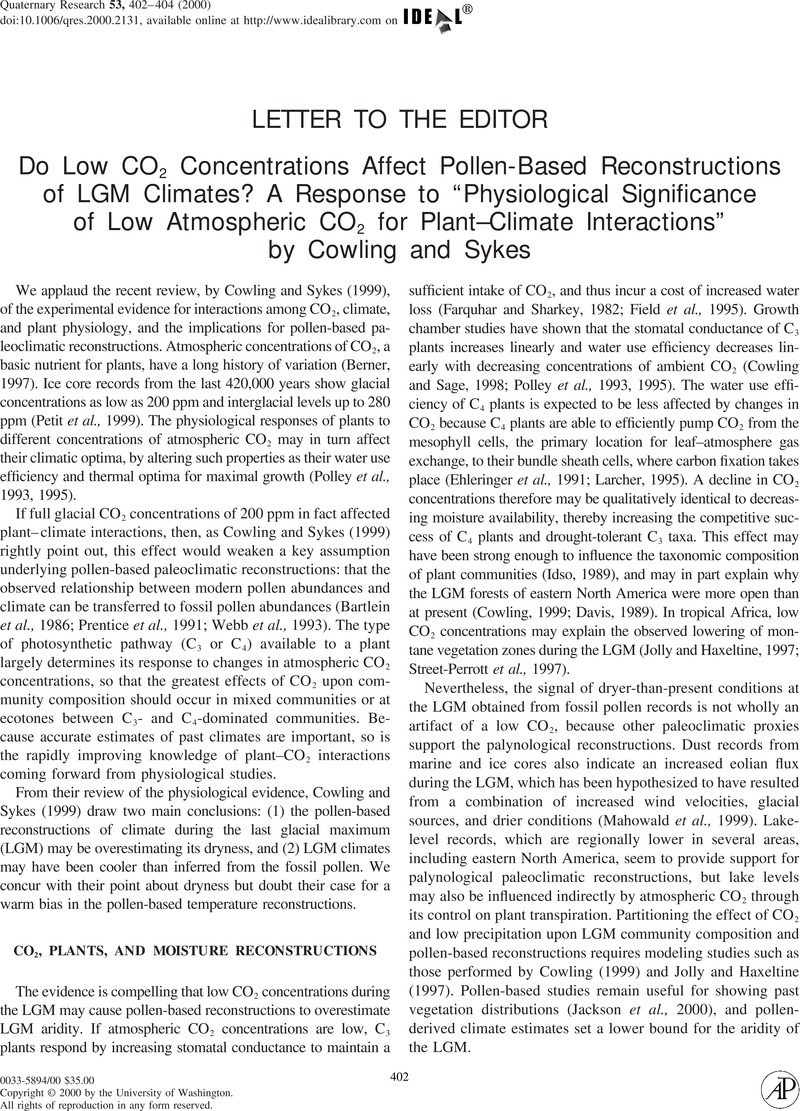Crossref Citations
This article has been cited by the following publications. This list is generated based on data provided by Crossref.
Hatté, Christine
Antoine, Pierre
Fontugne, Michel
Lang, Andreas
Rousseau, Denis-Didier
and
Zöller, Ludwig
2001.
δ13C of Loess Organic Matter as a Potential Proxy for Paleoprecipitation.
Quaternary Research,
Vol. 55,
Issue. 1,
p.
33.
Williams, John W.
Shuman, Bryan N.
and
Webb, Thompson
2001.
DISSIMILARITY ANALYSES OF LATE-QUATERNARY VEGETATION AND CLIMATE IN EASTERN NORTH AMERICA.
Ecology,
Vol. 82,
Issue. 12,
p.
3346.
Marchant, Robert
Boom, Arnoud
and
Hooghiemstra, Henry
2002.
Pollen-based biome reconstructions for the past 450 000 yr from the Funza-2 core, Colombia: comparisons with model-based vegetation reconstructions.
Palaeogeography, Palaeoclimatology, Palaeoecology,
Vol. 177,
Issue. 1-2,
p.
29.
Keeley, Jon E.
and
Rundel, Philip W.
2003.
Evolution of CAM and C4Carbon‐Concentrating Mechanisms.
International Journal of Plant Sciences,
Vol. 164,
Issue. S3,
p.
S55.
Marchant, Robert
Boom, Arnoud
Behling, Hermann
Hooghiemstra, Henry
Melief, Bert
Geel, Bas Van
Hammen, Thomas Van der
and
Wille, Michael
2004.
Colombian vegetation at the Last Glacial Maximum: a comparison of model‐ and pollen‐based biome reconstructions.
Journal of Quaternary Science,
Vol. 19,
Issue. 7,
p.
721.
Frenzel, Burkhard
2005.
Progress in Botany.
Vol. 66,
Issue. ,
p.
409.
Wu, Haibin
Guiot, Joël
Brewer, Simon
Guo, Zhengtang
and
Peng, Changhui
2007.
Dominant factors controlling glacial and interglacial variations in the treeline elevation in tropical Africa.
Proceedings of the National Academy of Sciences,
Vol. 104,
Issue. 23,
p.
9720.
Wu, Haibin
Guiot, Joël
Brewer, Simon
and
Guo, Zhengtang
2007.
Climatic changes in Eurasia and Africa at the last glacial maximum and mid-Holocene: reconstruction from pollen data using inverse vegetation modelling.
Climate Dynamics,
Vol. 29,
Issue. 2-3,
p.
211.
Gasse, Françoise
Chalié, Françoise
Vincens, Annie
Williams, Martin A.J.
and
Williamson, David
2008.
Climatic patterns in equatorial and southern Africa from 30,000 to 10,000 years ago reconstructed from terrestrial and near-shore proxy data.
Quaternary Science Reviews,
Vol. 27,
Issue. 25-26,
p.
2316.
Prentice, I. C.
and
Harrison, S. P.
2009.
Ecosystem effects of CO2 concentration: evidence from past climates.
Climate of the Past,
Vol. 5,
Issue. 3,
p.
297.
Gajewski, Konrad
and
Viau, Andre E.
2011.
Abrupt Climate Change: Mechanisms, Patterns, and Impacts.
Vol. 193,
Issue. ,
p.
161.
Mason, J.A.
Swinehart, J.B.
Hanson, P.R.
Loope, D.B.
Goble, R.J.
Miao, X.
and
Schmeisser, R.L.
2011.
Late Pleistocene dune activity in the central Great Plains, USA.
Quaternary Science Reviews,
Vol. 30,
Issue. 27-28,
p.
3858.
Marlon, Jennifer R.
Pederson, Neil
Nolan, Connor
Goring, Simon
Shuman, Bryan
Robertson, Ann
Booth, Robert
Bartlein, Patrick J.
Berke, Melissa A.
Clifford, Michael
Cook, Edward
Dieffenbacher-Krall, Ann
Dietze, Michael C.
Hessl, Amy
Hubeny, J. Bradford
Jackson, Stephen T.
Marsicek, Jeremiah
McLachlan, Jason
Mock, Cary J.
Moore, David J. P.
Nichols, Jonathan
Peteet, Dorothy
Schaefer, Kevin
Trouet, Valerie
Umbanhowar, Charles
Williams, John W.
and
Yu, Zicheng
2017.
Climatic history of the northeastern United States during the past 3000 years.
Climate of the Past,
Vol. 13,
Issue. 10,
p.
1355.
Chevalier, Manuel
Davis, Basil A.S.
Heiri, Oliver
Seppä, Heikki
Chase, Brian M.
Gajewski, Konrad
Lacourse, Terri
Telford, Richard J.
Finsinger, Walter
Guiot, Joël
Kühl, Norbert
Maezumi, S. Yoshi
Tipton, John R.
Carter, Vachel A.
Brussel, Thomas
Phelps, Leanne N.
Dawson, Andria
Zanon, Marco
Vallé, Francesca
Nolan, Connor
Mauri, Achille
de Vernal, Anne
Izumi, Kenji
Holmström, Lasse
Marsicek, Jeremiah
Goring, Simon
Sommer, Philipp S.
Chaput, Michelle
and
Kupriyanov, Dmitry
2020.
Pollen-based climate reconstruction techniques for late Quaternary studies.
Earth-Science Reviews,
Vol. 210,
Issue. ,
p.
103384.
Cadd, Haidee
Petherick, Lynda
Tyler, Jonathan
Herbert, Annika
Cohen, Tim J
Sniderman, Kale
Barrows, Timothy T.
Fulop, Reka H.
Knight, Jasper
Kershaw, A. Peter
Colhoun, Eric A.
and
Harris, Mathew R.P.
2021.
A continental perspective on the timing of environmental change during the last glacial stage in Australia.
Quaternary Research,
Vol. 102,
Issue. ,
p.
5.
Grigg, Laurie D.
Engle, Kevin J.
Smith, Alison J.
Shuman, Bryan N.
and
Mandl, Maximilian B.
2021.
A multi-proxy reconstruction of climate during the late-Pleistocene to early Holocene transition in the northeastern, USA.
Quaternary Research,
Vol. 102,
Issue. ,
p.
188.
Davis, Basil A. S.
Fasel, Marc
Kaplan, Jed O.
Russo, Emmanuele
and
Burke, Ariane
2024.
The climate and vegetation of Europe, northern Africa, and the Middle East during the Last Glacial Maximum (21 000 yr BP) based on pollen data.
Climate of the Past,
Vol. 20,
Issue. 9,
p.
1939.
Vimpere, Lucas
2024.
Parabolic dune distribution, morphology and activity during the last 20 000 years: A global overview.
Earth Surface Processes and Landforms,
Vol. 49,
Issue. 1,
p.
117.
Rentier, Eline S.
Mottl, Ondřej
Pacheco-Riaño, L. Camila
Schultz, Lotta
Seguinot, Julien
Wiersma, Abe T.
Grytnes, John-Arvid
and
Flantua, Suzette G. A.
2025.
Global variability in LGM cooling amongst paleoclimate datasets affects biome reconstructions in mountains.
Frontiers of Biogeography,
Vol. 18,
Issue. ,



